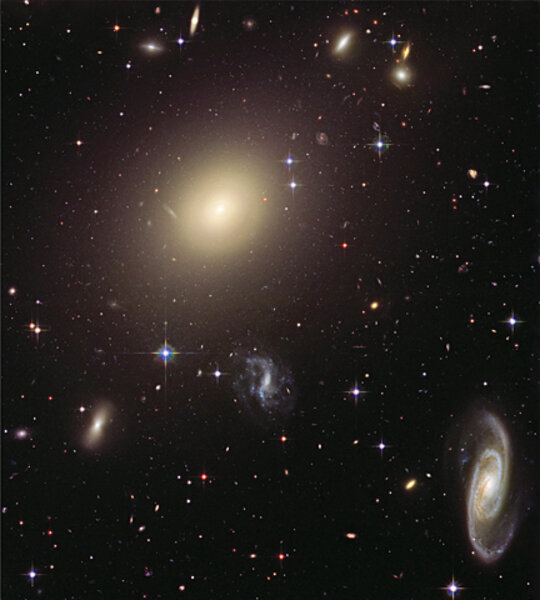Hey, space hounds! Here's our top space stories of 2010. What are yours?
Loading...
The year 2010 fairly burst with astronomical discoveries, secret space-plane launches, and more questions than answers about the direction of the US human spaceflight program.
Here's our sampler of some of the most interesting and significant. Is your favorite missing? Post your candidates in our comments section and we'll compile a year-end list for posting online:
Universe's baby pictures
In January, astronomers unveiled the first results from the Hubble Space Telescope's first "ultradeep field" survey, conducted in 2009. The haul: images of galaxies from a remarkable period in the history of the 13.6-billion-year-old universe. The 113 galaxies, which existed when the universe was between 600 million and 800 million years old, would have helped lift the universe out of its dark age – a period following the "big bang" when the initially hot universe cooled to a point where it generated no light.
The team also identified three galaxy "candidates" that, if confirmed, would have existed when the universe was about 500 million years old.
The images were gifts that will keep on giving. In October, for instance, another team using a large ground-based telescope reported that it had gathered a faint bit of spectrum from one of these galaxies. The spectral signature suggested the vast clump of stars and gas the team observed was on the order of 600 million years old. The findings corroborated what Hubble had found and suggested that scientists were witnessing the process that brought the universe out of its dark age.
The measurement was a tough one to make, and some astronomers are skeptical of the results because the galaxy in question is so faint. Still, the two related results highlight the power of using space- and ground-based telescopes in tandem, and the keen interest cosmologists have in learning more about this period in the universe's evolution.
Water in weird places
In April, astronomers announced they had discovered water ice and complex organic molecules on the surface of 24 Themis, a 123-mile-wide asteroid on the outside edge of a belt of asteroids that circles the sun between the orbits of Mars and Jupiter.
The surprise? Themis is too close to the sun for ice to survive on its surface long enough to be observed. By all rights, ice there should sublimate – quickly shift from a solid to a gas, then vanish. Unless, that is, a large reservoir of water exists below the frigid, dust-covered surface to replace sublimating ice.
Oh yes, and no one had seen evidence of organic molecules on asteroids before. Astronomers say that asteroids similar to Themis could well have played a pivotal role in delivering water and complex organic molecules to Earth.
And maybe the moon as well? In October, scientists with the National Aeronautics and Space Administration's LCROSS mission formally unveiled results from the LCROSS spacecraft's intentional collision with the bottom of Cabeus Crater at the moon's south pole.
In analyzing the debris the collision kicked up, scientists found evidence of water – estimated at about 12 gallons per ton of lunar soils at the impact site. They were anticipating that. But they also found carbon dioxide, methane, mercury, and small amounts of silver – compounds not on their original hunt-for list.
Water would be an important resource for human explorers trying to survive on the moon: Water trapped in the polar craters, some of which are the coldest spots in the solar system, also speaks to a moon that appears to have its own tenuous water cycle – water changing state and location during the lunar day. A moon that's dull and boring? Say what?
Milky Way's burping black hole
Astronomers using NASA's Fermi gamma-ray telescope were on the hunt for evidence that might betray the presence of so-called dark matter in the Milky Way. Instead, they were treated to the appearance of two large gamma-ray bubbles emerging from the Milky Way's center in opposite directions. Traveling at some 2.2 million miles per hour (light goes 670 million m.p.h.), the bubbles stretch for at least 25,000 light-years in each direction. Astrophysicists have put up two explanations for the gamma-ray belch:
1. A million-year-old "thank you" to the rest of the galaxy from a supermassive black hole at its core for the meal of stars, dust, and gas it gobbled during its most recent activity.
2. A sign that the center of the galaxy underwent a recent intense burst of star formation.
For now, the bubbles remain a "Hey, wouldja look at that!" discovery.
Out-of-this-world planets
In January, NASA's Kepler probe, which is surveying 156,000 stars, found its first five planets, each at least the size of Neptune. The team working with Kepler estimates that one is less dense than styrofoam and all orbit so close to their host stars that their temperatures range from that of lava to that of molten iron.
In August, the team announced its first multiplanet star, hosting a pair of planets with masses similar to Jupiter's. Each of these giants would be orbiting well within Mercury's orbit if they were placed in our solar system.
This month, the team published a paper in the Astrophysical Journal describing five stars that each appear to host two or three planet "candidates" with orbital periods ranging from just more than two days to just more than 51. The objects will remain candidates until they can be confirmed by ground-based observations.
Kepler's mission is to find Earth-mass planets orbiting sunlike stars at Earth-like distances, but giant planets orbiting close to their stars are easiest to spot.





